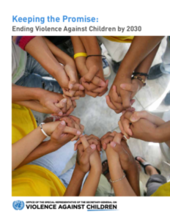This report outlines a number of key risk factors, including discrimination, poverty, disability and gender, with girls affected disproportionately by certain forms of violence, boys affected more than we once thought, and both unlikely to report the violence they experience. The report builds on the ground-breaking 2006 United Nations Study on Violence against Children, (the United Nations Study) and on 10 years of the implementation of its recommendations promoted by the mandate of the Special Representative. It also draws on expert contributions from a range of organizations, to reveal a new clarity of vision. These diverse sources yield markedly similar conclusions on the ingredients for success across five key areas.
1. Strengthening legal and policy frameworks
2. Reinforcing the protective shield around children
3. More and better data and research
4. Widening partnership: building the global movement to end violence against children
5. Amplifying the voice of children.
All five areas require massive additional investment from multiple sources. Governments have a lead responsibility, including in the allocation of all available resources to their maximum extent, in ensuring child-centred budgets and investments in legal and child protection systems and in strengthening data and evidence on violence against children.

